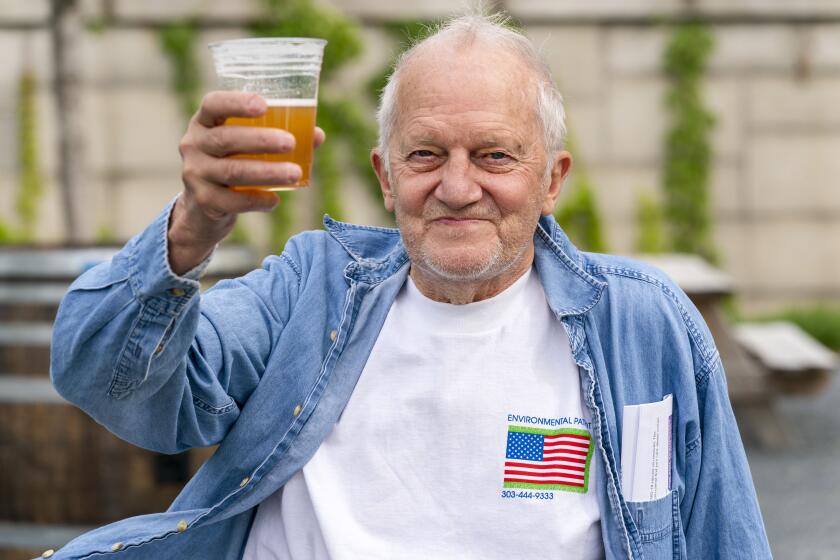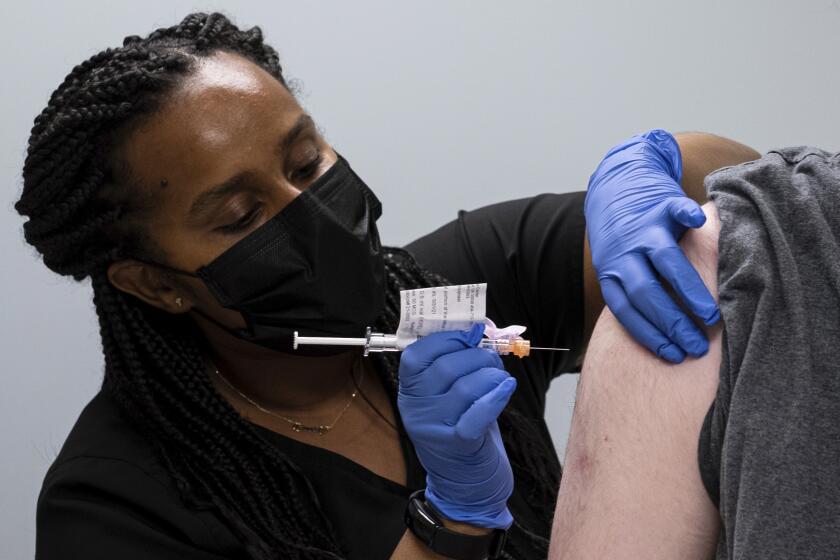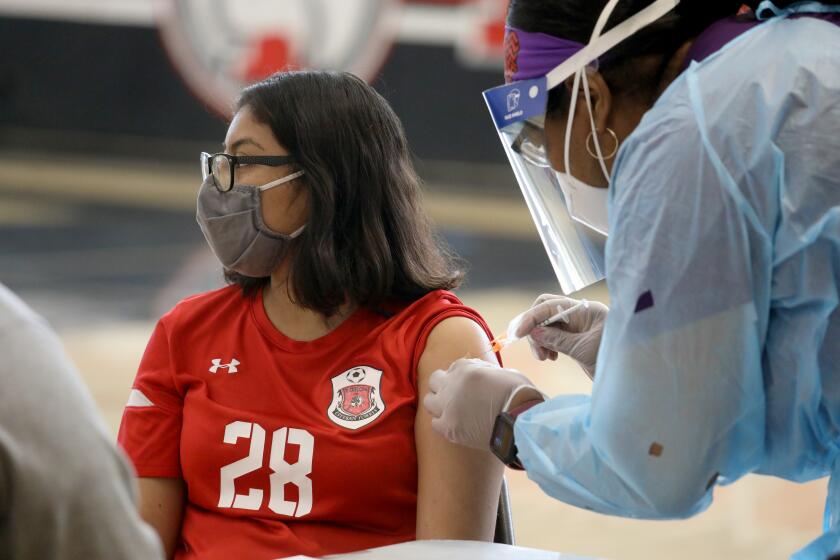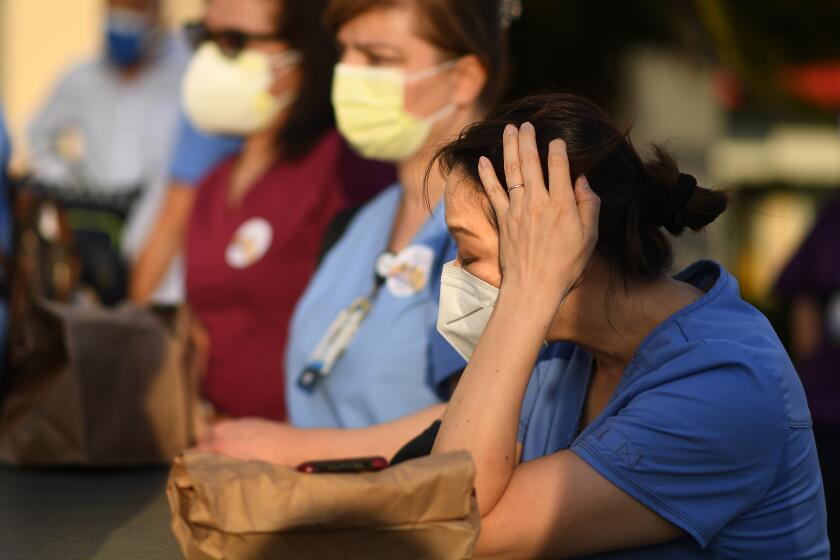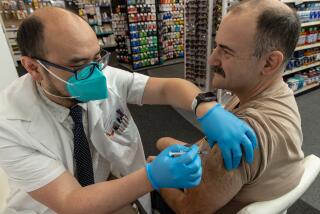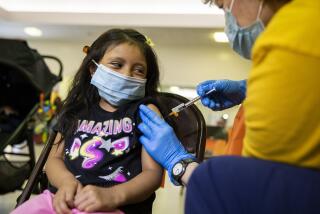L.A.’s youngest Black and Latino residents are least likely to be vaccinated for COVID-19
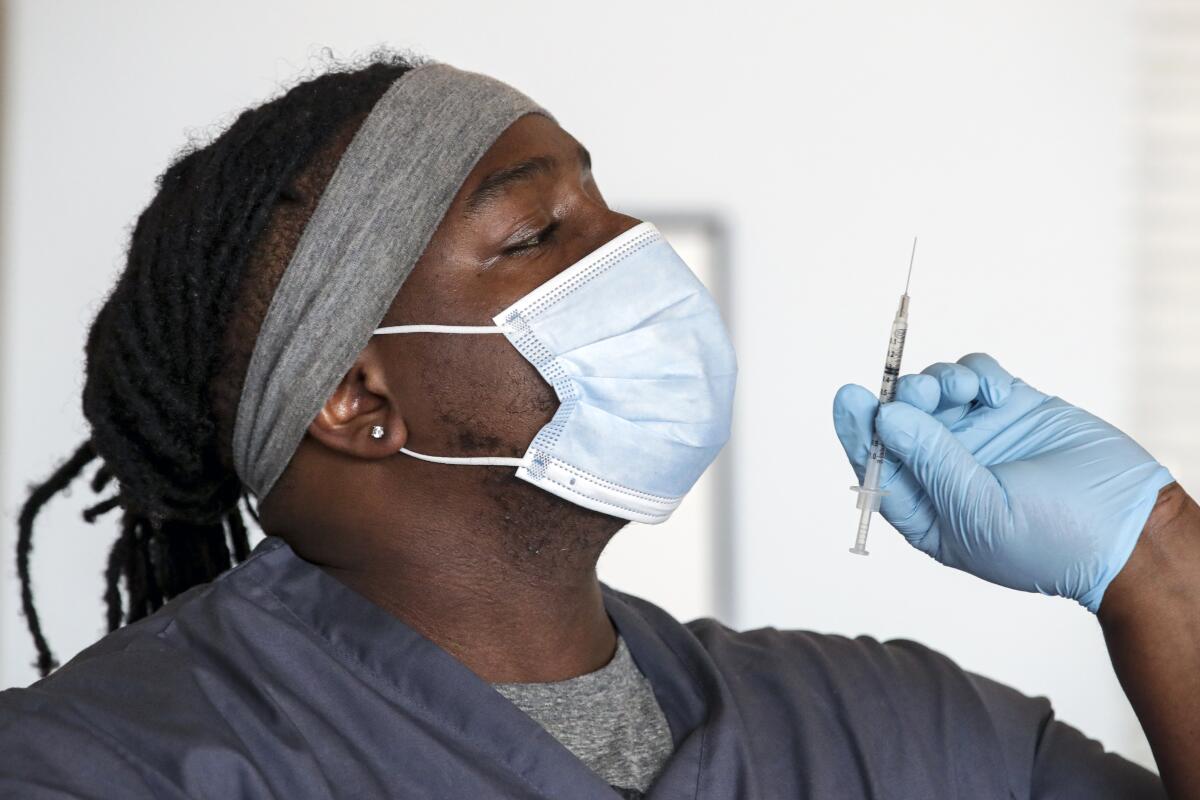
- Share via
In a troubling sign, rates of COVID-19 vaccinations among Los Angeles County’s youngest eligible Black and Latino residents are significantly lower than for other racial and ethnic groups, and officials are expanding efforts to make shots available across the region.
Among people 16 and older, only 41% of Black residents and 48% of Latino residents in L.A. County have received at least one shot; by contrast, 63% of white, 59% of Native American and 71% of Asian American residents are at least partially vaccinated. Countywide, 64% of residents in this age group have received at least one dose of vaccine.
The disparities are contributing to the increased chance of infection, hospitalization and death among Black and Latino residents from COVID-19.
Black residents are now about twice as likely, and Latinos about 60% more likely, to be hospitalized with COVID-19 than white residents in L.A. County. Black and Latino residents also have roughly twice the risk of dying of COVID-19 than white residents in the county.
“This is really concerning. As we’ve witnessed, Black and brown residents, as essential workers, bore the brunt of this pandemic, especially noticeable during the surge,” L.A. County Public Health Director Barbara Ferrer said. “If they’re not protected by the vaccine with the lifting of public health safety measures, they can again have the highest risk of getting infected, being hospitalized or dying from this virus.”
Free beer is the latest incentive endorsed by the White House to persuade Americans to get vaccinated for COVID-19.
The overall pace of vaccinations has also slowed considerably in L.A. County. There are now about 100,000 first-dose vaccinations being administered each week, a fraction of the roughly 500,000 a week earlier this year, prompting Ferrer to revise her estimate of when the county will reach its goal of having 80% of residents 16 and older at least partially vaccinated. To do so, the county must administer 1.1 million more doses, Ferrer said. Instead of achieving that goal in mid- to late July, as she projected a month ago, she now expects it to be achieved in late August.
“I am hopeful that we’ve stabilized at about 100,000 [first] doses a week,” Ferrer said. “I think if we continue to make all of the efforts that we’re doing with all of our partners, we will get there in August.”
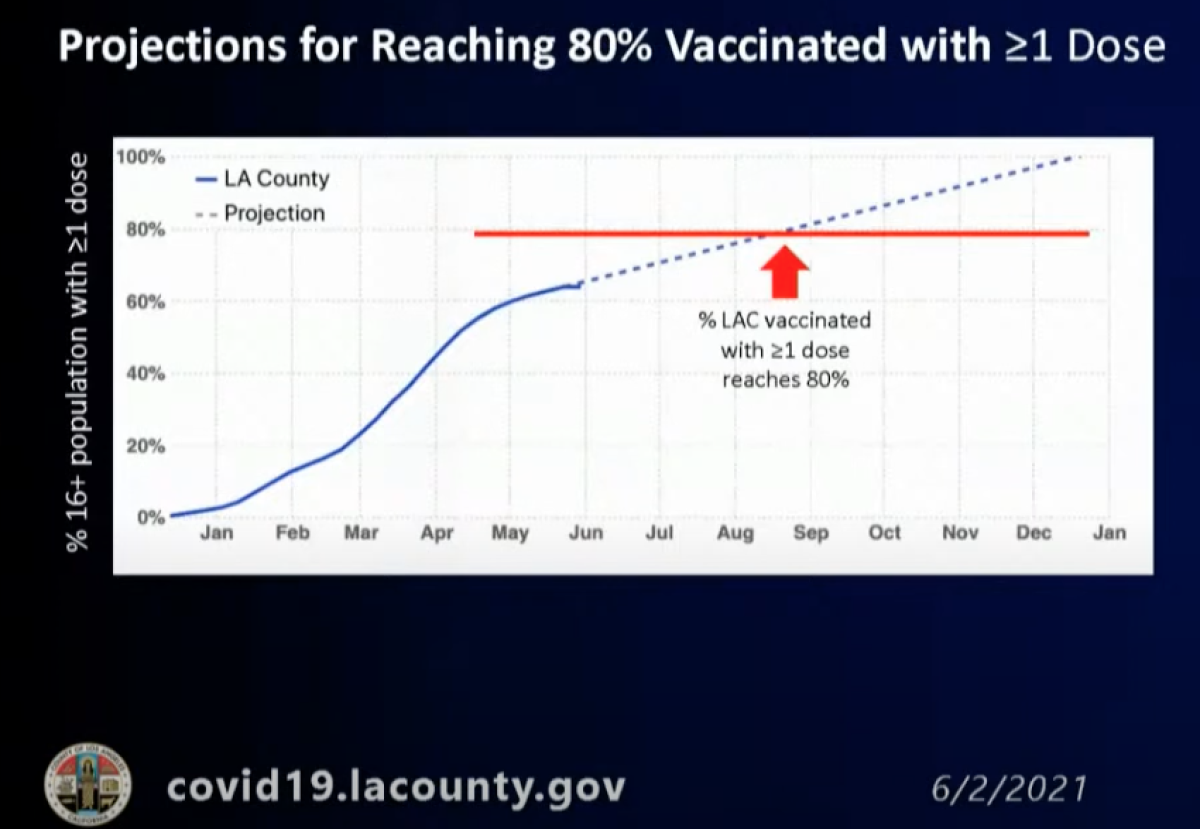
Ferrer said she hopes that as more people see their friends and family get the vaccines without major problems, they’ll be convinced to get the shot.
The disparities in vaccinations are particularly stark in the youngest age groups. Among adults in their 20s or younger, just 24% of Black and 37% of Latino residents have received at least one dose of vaccine; by comparison, 54% of white, 53% of Native American and 70% of Asian American residents in this age group have gotten at least one shot.
The world’s leading COVID-19 vaccines may offer lasting protection that diminishes the need for frequent booster shots, scientists say.
Even among adults in their 30s and 40s, significant disparities exist: Thirty-five percent of Black and 45% of Latino residents have received at least one dose; by contrast, 60% of white, 61% of Native American and 69% of Asian American residents in this group have received at least one dose.
The inequities reflect a number of complicated issues, Ferrer said, including a historical lack of medical resources in underserved communities. Officials have struggled to convince some residents that the vaccine truly is free — and there aren’t hidden fees that will come later — and that getting the vaccine won’t affect immigration status.
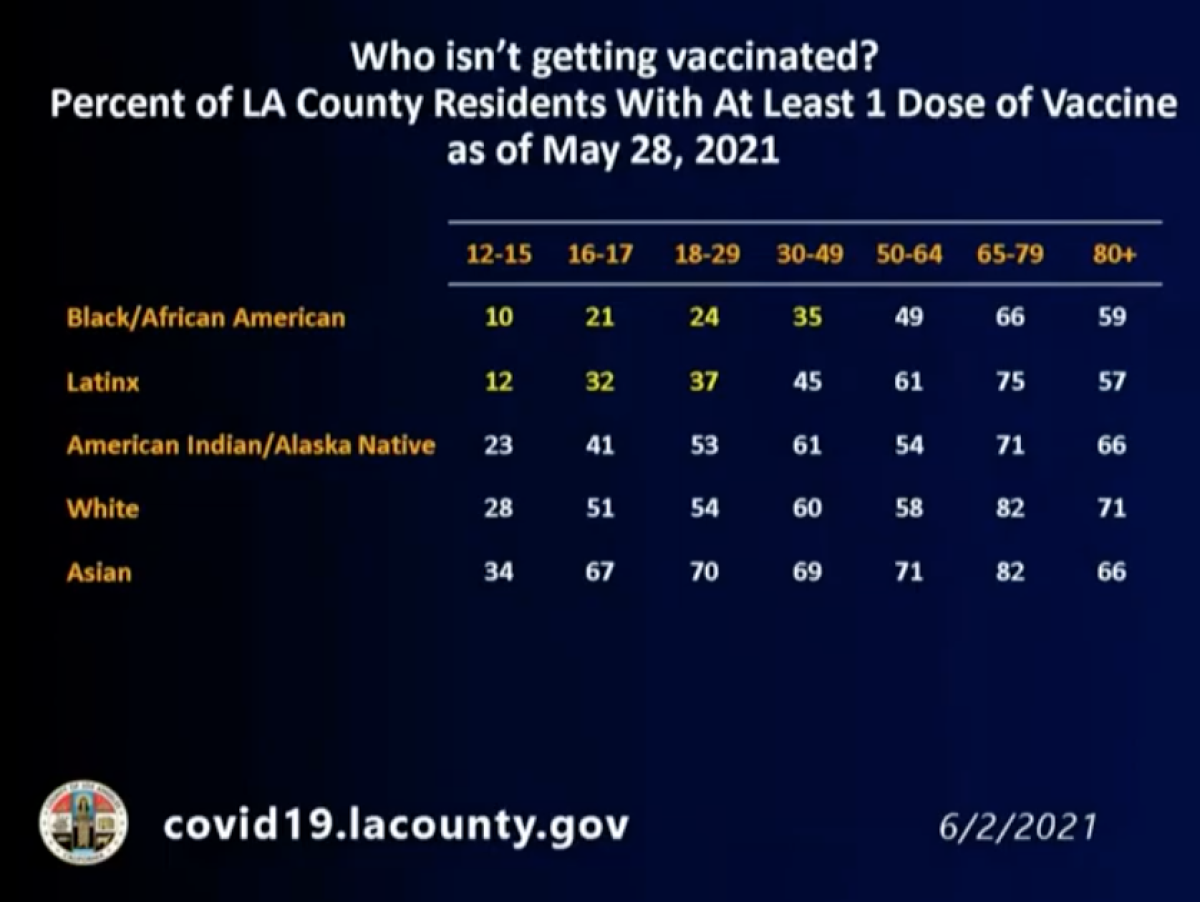
Getting the vaccine is also more challenging for lower-income residents who may be working two or more jobs and worry about the potential for having to take a day or two off to deal with the mild side effects, like a fever or fatigue, that can sometimes happen after receiving the shot, she said. Officials are trying to make it easier for those people to get vaccinated by setting up clinics at workplaces and other convenient sites.
Officials are already trying to promote interest in vaccinations with prizes. The state has launched a $116.5-million incentive program that will award 10 Californians a prize of $1.5 million each and 30 more residents $50,000 apiece, while offering 2 million residents eligibility to get $50 prepaid gift or grocery cards.
California’s ‘Vax for the Win’ program seeks to boost interest in vaccines by offering cash rewards. If you’ve gotten a shot, you’re already eligible.
In L.A. County, adults who get vaccinated between Friday and Thursday at sites run by the county, the city of Los Angeles or St. John’s Well Child and Family Center will be eligible to win season tickets to the Dodgers or the Los Angeles Football Club soccer team.
Past incentives, such as a sweepstakes for Lakers tickets, seem to have been on the minds of a number of people coming into vaccine clinics lately, Ferrer said. Sometimes, as many as half are aware of the prizes and sweepstakes, Ferrer said.
Germany, Greece and five other European Union nations have introduced a COVID-19 vaccination certificate system on the eve of summer tourist season.
Ferrer also urged people to encourage their friends, family and neighbors to get vaccinated. People can look for vaccination sites at VaccinateLACounty.com; sites run by the city and county of Los Angeles and most community and mobile sites now offer shots without appointments, and many are open on weekends and evenings.
“We can share our own stories, share what it was that helped us make our decision…. And we can offer our company and our encouragement to get those in our community to any of the hundreds of vaccination sites across the county when people are ready to get their vaccines,” Ferrer said.
Officials are positioning scores of mobile vaccine sites in places hardest hit by the pandemic — at workplaces, schools, churches and senior centers — and are moving to set up clinics at gathering places such as Universal CityWalk, beaches and museums.
Assembly Bill 650 by Assemblyman Al Muratsuchi (D-Rolling Hills Estates) would award $10,000 bonuses to California healthcare workers. The pay would be spread out in hopes that the cash would entice healthcare workers to remain in their job.
More to Read
Sign up for Essential California
The most important California stories and recommendations in your inbox every morning.
You may occasionally receive promotional content from the Los Angeles Times.
